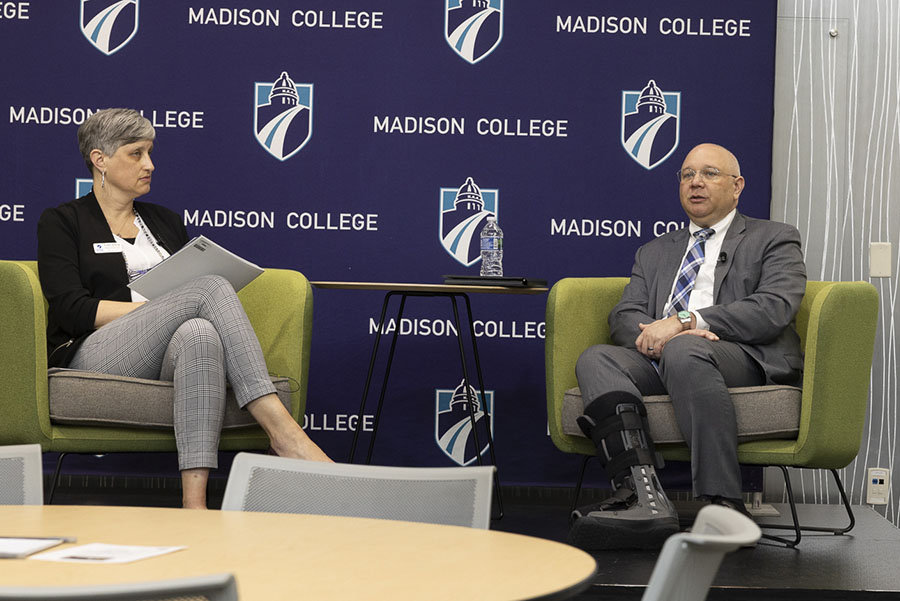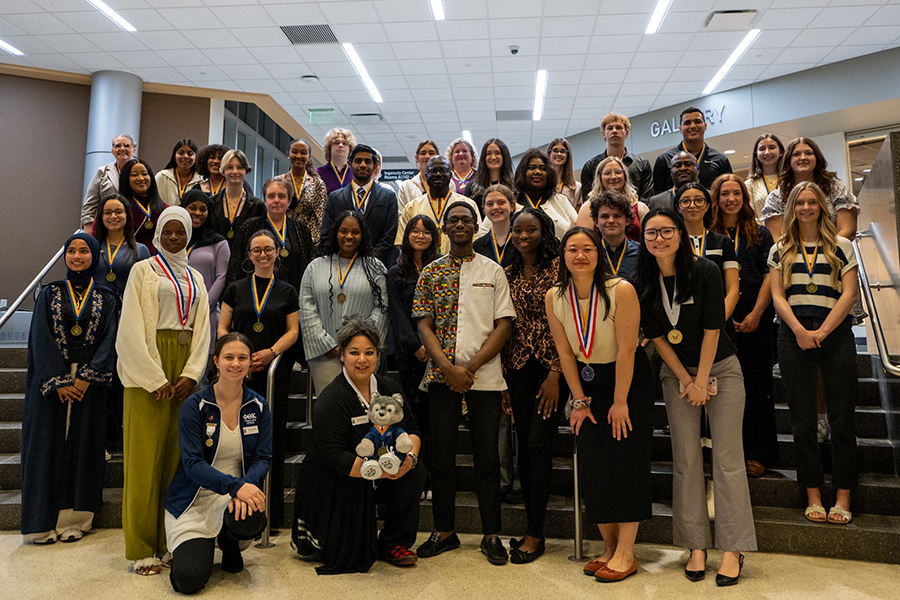MASTATAL, COSTA RICA – Roosters blared their daily wake up calls as everyone downed their last sips of coffee. Though it was early, the sun was already high in the sky. Birds and insects chirped, and the surrounding mountains disappeared into a distant fog. A group of around 30 students, teachers, and locals bustled around, fretting over the last-minute details of that day’s solar panel installation.
Among those present were several students from Madison Area Technical College. It was their seventh day of the nine-day study abroad course, “Renewable Energy for International Development.” Supervised by Dr. Kenneth Walz, a Madison College professor, and Dr. Geoffrey Bradshaw, director of international education, students in the course learned about solar powered systems capable of lighting small homes and, in some cases, even running small appliances.
On Jan. 7, the students enjoyed the early-morning freshness as they anticipated a much hotter and dryer day. It consisted of a difficult hike to an off-grid home in the Zapaton region. Domingo, the home’s owner, was scheduled to receive a solar powered lighting system from Solar Energy International that day.
Founded in 1991, Solar Energy International runs solar power installation/education projects in many parts of Central America and around the world. Groups from Madison College have worked in conjunction with the organization in Costa Rica for the past four years. Since then, they have installed solar panels in around a dozen remote locations.
In a tropical country like Costa Rica, sun is abundant, especially in the dry season. Once installed, a system run by solar power has no operational or fuel costs. Maintenance is the only future expense and most parts of the system come with extensive warrantees. Due to this, solar power has become increasingly popular in Costa Rica.
“Of all the countries in the world right now, Costa Rica is really pushing the envelope in terms of their energy infrastructure,” Walz explained.
With most energy already produced in the form of hydropower, Costa Rica’s goal is to be carbon-neutral by 2021. Education about sustainability options, like that provided by Solar Energy International, is key to reaching this goal.
On this particular project the solar powered system was fully installed by students and their advisors. They did everything from profiling Domingo’s energy consumption, to planning the wiring, lighting and battery choices. For many, the experience was like nothing they had ever done before.
“Some of the students started the week not knowing the difference between an amp and a volt,” said Ian Woofenden, Northwest and Costa Rica Coordinator for Solar Energy International. “But these [systems] aren’t that complicated. We are dealing with a few components. We have a solar electric module. We have a charge controller. We have a battery. We have some breakers, and some wire and some lights. So it’s fairly straight forward.”
The students completed many classroom hours and even some hands on work by the time they left for Zapaton. They piled into the backs of four vehicles packed full with equipment. The caravan took them as far as possible into the mountains then dropped them on the side of the road.
From there they tripped and slid their way down a rugged mountain path. With the amount of people in the group and a skinny horse laden with too many heavy supplies, it took about 45 minutes to reach the Domingo’s home.
The house was simple and set deep within green jungle on a deserted mountainside. It was constructed of mostly wooden walls and a tin roof. The floor was nothing but pressed earth, and the bathroom was a small outhouse adjacent to the main building. The most frequent visitors were tropical birds and exotic insects.
Domingo, a lean, elderly man with wiry muscles and piercing black eyes, had lived on the mountainside for around 14 years. He said he would be happy to live out the rest of his life in the quiet sanctuary. Though he lacked material wealth, it was clear that many of the students had no trouble understanding why Domingo would say that.
“The people [here] live a better lifestyle than us in a lot of ways.” said Woofenden. “[Domingo] has time. He’s with his family a lot. He is generous and kind.”
For Domingo, there was an obvious advantage to bringing in a group like Solar Energy International. By the end of the day, he would have five light emitting diodes (LEDs) lighting various parts of his home. Electric lights were something Domingo never had before. They allow him to work later into the evening doing things like whittling, something he enjoys in his free time but his poor eyesight prevents. However, Domingo was not the only one to benefit from the experience.
“To bring light to somebody who hasn’t had it, I mean, that’s a good feeling,” said one student with Solar Energy International.
Both Walz and Woofenden agree that it was the students who benefited the most from the experience. Not only is there a tangible accomplishment upon completion, the experience is far from that of a classroom. According to Bradshaw, there are two main parts of the learning process: the hands on experience and having that experience in a context other than the United States.
“I think studying sustainability in an context like this, next to the rainforest, in a place where you can go for a 10 minute walk, swim in a waterfall and see white-faced monkeys, really helps you appreciate why those solar panels are important,” Walz explained.
During the pre-install interview, Domingo expressed his excitement about the new lights. He wanted to learn everything he could from the group. A translator was provided to walk him through every step of the process. Part of the program’s goal is to train locals to maintain the systems.
After the interview with Domingo, the group split into teams. Some worked on preparing the roof for the solar panels, while others worked on the battery box, ran wire and PVC pipe, and assembled light fixtures. Another group worked on the solar panel itself. By the time lunch was served, most of the system had been installed. Still, there was several hours of work left to do.
“It’s always the unexpected things that hold you up,” Bradshaw explained.
In this case it was the glue on the light fixtures. Because of the extreme heat, the glue took a long time to solidify causing parts to slip out of place.
Also, with so many people working on the project, there was some overcrowding. Although most were completely satisfied with the experience, some students wished they had gotten more hands-on time. Regardless of this, they finished the installation around 3 p.m.
Domingo smoked tobacco out of his pipe and cut chunks of sugar cane for the group to chew as they packed up equipment. He listened to the final information needed to maintain the lights, nodded his understanding, and asked questions when they came up.
When all was said and done, the group walked back up the mountain in near silence. Although he didn’t have to, Domingo followed them, talking about his life and his excitement for the new lights.
“Lo tomo como un regalo de Navidad, como que Dios me los viera mandado a ustedes,” Domingo said, raising his arms to the sky. (I take it as a Christmas present, as if God had sent you all to me.)
Far across the mountain range, the Pacific glowed bright gold in the late afternoon light. Students and faculty alike were filled with a sense of accomplishment. Waving a last goodbye from the back of the pick-up, many participants said it was an experience they would never forget.


























